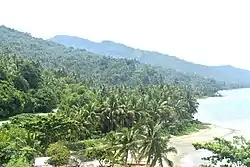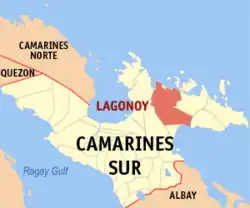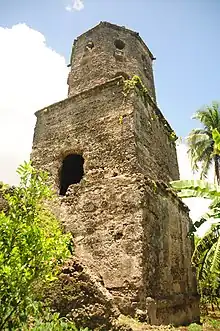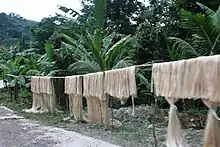Lagonoy | |
|---|---|
| Municipality of Lagonoy | |
 Lagonoy Beach | |
 Flag | |
| Nickname: The True Heart of Partido | |
| Motto: Dagos Ang Pag-asenso | |
 Map of Camarines Sur with Lagonoy highlighted | |
OpenStreetMap | |
.svg.png.webp) Lagonoy Location within the Philippines | |
| Coordinates: 13°44′07″N 123°31′15″E / 13.7353°N 123.5208°E | |
| Country | Philippines |
| Region | Bicol Region |
| Province | Camarines Sur |
| District | 4th district |
| Founded | 1763 |
| Barangays | 38 (see Barangays) |
| Government | |
| • Type | Sangguniang Bayan |
| • Mayor | Delfin F. Pilapil III |
| • Vice Mayor | Jerry Jake R. Remoto |
| • Representative | Arnulf Bryan B. Fuentebella |
| • Municipal Council | Members |
| • Electorate | 38,858 voters (2022) |
| Area | |
| • Total | 377.90 km2 (145.91 sq mi) |
| Elevation | 12.8 m (42.0 ft) |
| Highest elevation | 473 m (1,552 ft) |
| Lowest elevation | 0 m (0 ft) |
| Population (2020 census)[4] | |
| • Total | 56,714 |
| • Density | 150/km2 (390/sq mi) |
| • Households | 12,225 |
| Economy | |
| • Income class | 2nd municipal income class |
| • Poverty incidence | 30.08 |
| • Revenue | ₱ 215.8 million (2020) |
| • Assets | ₱ 366.1 million (2020) |
| • Expenditure | ₱ 175 million (2020) |
| • Liabilities | ₱ 133.3 million (2020) |
| Service provider | |
| • Electricity | Camarines Sur 4 Electric Cooperative (CASURECO 4) |
| Time zone | UTC+8 (PST) |
| ZIP code | 4425 |
| PSGC | |
| IDD : area code | +63 (0)54 |
| Native languages | Central Bikol Tagalog |
Lagonoy, officially the Municipality of Lagonoy (Central Bikol: Banwaan kan Lagonoy; Tagalog: Bayan ng Lagonoy), is a 2nd class municipality in the province of Camarines Sur, Philippines. According to the 2020 census, it has a population of 56,714 people.[4]
Etymology
There are two version as how Lagonoy got its name. Year 1734 when the first Spaniards in this place found a small forested area near a creek where "hagonoy", a medicinal plant grew abundantly. Because the Spaniards could hardly pronounce the word "hagonoy" with the "j" sound, with "ha" of the first syllable, they deliberately decided to change "ha" to "la". Since then, the place was known as "Lagonoy". Some of the residents also believed that the name was taken from the word "lango" meaning drunk. During fiestas and other forms or merry making, men used to drink too much "tuba" (native wine) that they become drunk or "lango" (Bikol for drunk) so that the place was called by the neighboring towns as "Lagonoy".[6]
History
In 1734, Partido towns of Caramoan, Lagonoy, Goa and Tigaon belonged to Albay. It was only in 1846 did Lagonoy belong to Camarines Sur. In a long research by Norman Owen, a feud between Lagonoy Parish and Franciscan Mission of Goa and Tigaon existed. In 1580, the administration by the Franciscans of Lagonoy Parish began until 1636, which was passed to the “mitre” of the bishop of Nueva Caceres. In 1580 to 1850, Lagonoy gulf had been very famous because of the constant moro raids in the Partido area and all coastal towns of Albay and Catanduanes. On the other hand, Lagonoy had other problems about the Remontados of Mt Isarog. F. Mallari, in his book- “Ibalon under siege and storm” said they were fallen Christians and confirmed by Fray Manuel Crespo, who spent many years inducing them to return to the town and live peacefully. Fray Matias de Valdesoto also noted in his visits to the sitios of Goa and Lagonoy that the natives planted corn, rice, root crops & tobacco.
Geography
Barangays
Lagonoy is politically subdivided into 38 barangays. Each barangay consists of puroks and some have sitios.
- Agosais
- Agpo-Camagong-Tabog
- Amoguis
- Bocogan
- Balaton
- Binanuahan
- Burabod
- Cabotonan
- Dahat
- Del Carmen
- Genorangan
- Gimagtocon
- Gubat
- Guibahoy
- Himanag
- Kinahologan
- Loho
- Manamoc
- Mangogon
- Mapid
- Olas
- Omalo
- Panagan
- Panicuan
- Pinamihagan
- San Francisco (Poblacion)
- San Isidro
- San Isidro Sur (Poblacion)
- San Isidro Norte (Poblacion)
- San Rafael
- San Ramon
- San Roque
- San Sebastian
- San Vicente (Poblacion)
- Santa Cruz
- Santa Maria (Poblacion)
- Saripongpong (Poblacion)
- Sipaco
Climate
| Climate data for Lagonoy, Camarines Sur | |||||||||||||
|---|---|---|---|---|---|---|---|---|---|---|---|---|---|
| Month | Jan | Feb | Mar | Apr | May | Jun | Jul | Aug | Sep | Oct | Nov | Dec | Year |
| Mean daily maximum °C (°F) | 31 (88) |
30 (86) |
32 (90) |
35 (95) |
35 (95) |
35 (95) |
34 (93) |
33 (91) |
34 (93) |
32 (90) |
30 (86) |
30 (86) |
33 (91) |
| Mean daily minimum °C (°F) | 26 (79) |
26 (79) |
28 (82) |
30 (86) |
31 (88) |
30 (86) |
29 (84) |
29 (84) |
29 (84) |
28 (82) |
27 (81) |
27 (81) |
28 (83) |
| Average precipitation mm (inches) | 82.88 (3.26) |
137.93 (5.43) |
63.69 (2.51) |
78.31 (3.08) |
229.42 (9.03) |
288.31 (11.35) |
280.99 (11.06) |
112.39 (4.42) |
210.87 (8.30) |
599.07 (23.59) |
194.80 (7.67) |
454.3 (17.89) |
2,732.96 (107.59) |
| Average rainy days | 24 | 28 | 18 | 20 | 24 | 29 | 31 | 27 | 27 | 30 | 29 | 31 | 318 |
| Source: World Weather Online[7] | |||||||||||||
Demographics
| Year | Pop. | ±% p.a. |
|---|---|---|
| 1903 | 9,725 | — |
| 1918 | 12,681 | +1.79% |
| 1939 | 18,852 | +1.91% |
| 1948 | 22,604 | +2.04% |
| 1960 | 31,525 | +2.81% |
| 1970 | 29,178 | −0.77% |
| 1975 | 33,297 | +2.68% |
| 1980 | 34,717 | +0.84% |
| 1990 | 38,163 | +0.95% |
| 1995 | 40,126 | +0.94% |
| 2000 | 42,636 | +1.31% |
| 2007 | 46,093 | +1.08% |
| 2010 | 51,814 | +4.35% |
| 2015 | 55,465 | +1.31% |
| 2020 | 56,714 | +0.44% |
| Source: Philippine Statistics Authority[8][9][10][11] | ||
In the 2020 census, the population of Lagonoy, Camarines Sur, was 56,714 people,[4] with a density of 150 inhabitants per square kilometre or 390 inhabitants per square mile.
Economy
Lagonoy is the chief supplier of "tiger grass" to the prominent soft broom "walis tambo makers" of North Luzon and some parts of Central Luzon.
Gallery
 Remaining belfry of old Lagonoy Church
Remaining belfry of old Lagonoy Church Portal to the Old Cemetery of Lagonoy
Portal to the Old Cemetery of Lagonoy Kinahulogan Falls
Kinahulogan Falls Caguiscan River
Caguiscan River Caguiscan Picnic Grove and Campsite
Caguiscan Picnic Grove and Campsite Abaca fibers produced in Lagonoy
Abaca fibers produced in Lagonoy
References
- ↑ Municipality of Lagonoy | (DILG)
- ↑ "2015 Census of Population, Report No. 3 – Population, Land Area, and Population Density" (PDF). Philippine Statistics Authority. Quezon City, Philippines. August 2016. ISSN 0117-1453. Archived (PDF) from the original on May 25, 2021. Retrieved July 16, 2021.
- ↑ Error: Unable to display the reference properly. See the documentation for details.
- 1 2 3 Census of Population (2020). "Region V (Bicol Region)". Total Population by Province, City, Municipality and Barangay. Philippine Statistics Authority. Retrieved 8 July 2021.
- ↑ "PSA Releases the 2018 Municipal and City Level Poverty Estimates". Philippine Statistics Authority. 15 December 2021. Retrieved 22 January 2022.
- ↑ Cultural Inventory of the 4th District of Camarines Sur (Project in Social Science 4 classes, A/Y 2001- 2002
- ↑ "Lagonoy, Camarines Sur: Average Temperatures and Rainfall". World Weather Online. Retrieved 29 October 2017.
- ↑ Census of Population (2015). "Region V (Bicol Region)". Total Population by Province, City, Municipality and Barangay. Philippine Statistics Authority. Retrieved 20 June 2016.
- ↑ Census of Population and Housing (2010). "Region V (Bicol Region)" (PDF). Total Population by Province, City, Municipality and Barangay. National Statistics Office. Retrieved 29 June 2016.
- ↑ Censuses of Population (1903–2007). "Region V (Bicol Region)". Table 1. Population Enumerated in Various Censuses by Province/Highly Urbanized City: 1903 to 2007. National Statistics Office.
{{cite encyclopedia}}: CS1 maint: numeric names: authors list (link) - ↑ "Province of Camarines Sur". Municipality Population Data. Local Water Utilities Administration Research Division. Retrieved 17 December 2016.
- ↑ "Poverty incidence (PI):". Philippine Statistics Authority. Retrieved December 28, 2020.
- ↑ "Estimation of Local Poverty in the Philippines" (PDF). Philippine Statistics Authority. 29 November 2005.
- ↑ "2003 City and Municipal Level Poverty Estimates" (PDF). Philippine Statistics Authority. 23 March 2009.
- ↑ "City and Municipal Level Poverty Estimates; 2006 and 2009" (PDF). Philippine Statistics Authority. 3 August 2012.
- ↑ "2012 Municipal and City Level Poverty Estimates" (PDF). Philippine Statistics Authority. 31 May 2016.
- ↑ "Municipal and City Level Small Area Poverty Estimates; 2009, 2012 and 2015". Philippine Statistics Authority. 10 July 2019.
- ↑ "PSA Releases the 2018 Municipal and City Level Poverty Estimates". Philippine Statistics Authority. 15 December 2021. Retrieved 22 January 2022.